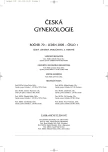Birth Defects in the Czech Republic – Expected Incidence in the Coming Years
Vrozené vady v České republice – odhady incidencí v příštích letech
Cíl studie:
Cílem studie je analýza odhadu výskytu vrozených vad jako celku a některých vybraných typů vrozených vad na podkladě průměrných hodnot za období let 1983–2002 v České republice. Zhodnocení možného výskytu vrozených vad v České republice v nejbližších letech.
Typ studie:
Statistický odhad a analýza odhadu na podkladě retrospektivních hodnot incidence vrozených vad z materiálu z Ústavu pro péči o matku a dítě a z Ústavu zdravotnických informací a statistiky České republiky.
Metodika:
Jde o odhad výskytu vrozených vad jako celku i podle jednotlivých vybraných typů s využitím exponenciálního vyrovnání časových řad s parametrem váhy pro jednotlivé roky retrospektivního období.
Výsledky a závěr:
Podle statistického odhadu by se mělo v České republice v letech 2003–2015 narodit 1 244 767 dětí. V tomto období by mělo být na území naší republiky zjištěno 50 706–67 628 prenatálně a postnatálně diagnostikovaných případů vrozených vad. Tyto naše výsledky představují odhad výskytu vrozených vad v České republice v nejbližších letech a představují odůvodnění dalšího fungování registrace vrozených vad v České republice. Epidemiologie vrozených vad totiž představuje multidisciplinární obor, jehož hlavním cílem je svými výsledky dávat podklady k hodnocení kvality prenatální a perinatální péče v České republice.
Klíčová slova:
vrozená vada, prenatální diagnostika, epidemiologie, incidence, odhad, anencefalie, spina bifida, defekty neurální trubice, omfalokéla, gastroschíza, defekty břišní stěny, cystické ledviny, ageneze/ hypoplazie ledvin, Downův syndrom
Authors:
A. Šípek 1,2; V. Gregor 3,4; J. Horáček 3,4; L. Krofta 1,2; D. Mašátová 5
Authors‘ workplace:
Ústav pro péči o matku a dítě, Praha – Podolí
ředitel doc. MUDr. J. Feyereisl, CSc.
1; Institut postgraduálního vzdělávání ve zdravotnictví, Praha, Katedra gyn. -por.
vedoucí doc. MUDr. J. Feyereisl, CSc.
2; Oddělení lékařské genetiky, Fakultní Thomayerova nemocnice, Praha
ředitel Ing. J. Pubrdle
3; Institut postgraduálního vzdělávání ve zdravotnictví, Praha, Katedra lékařské genetiky
ředitel MUDr. A. Malina, Ph. D.
4; Ústav zdravotnických informací a statistiky České republiky, Praha
ředitelka Mgr. V. Mazánková
5
Published in:
Ceska Gynekol 2005; 70(1): 37-43
Category:
Original Article
Overview
Objective:
The study was aimed to analyze expected incidence of birth defects as a whole and some selected types of birth defects on the basis of the mean values over the period of 1983–2002 in the Czech Republic. A possible incidence of birth defects in the Czech Republic in the coming years was evaluated.
Design:
A statistical estimate and analysis of the expected incidence based on retrospective values of incidence of birth defects from the data of the Institute of the Care of Mother and Child (UPMD) and the Institute of Medical Information and Statistics of the Czech Republic (UZIS).
Methods:
The estimate of incidence of birth defects as a whole as well as according to individual selected types with the application of exponential adjustment of time series with the time-weighted parameter for individual years of the retrospective period of time.
Results and conclusions:
The statistical estimate indicates that 1 244 767 children should be born in the Czech Republic over the period of 2003–2015. In this period of time there should be 50,706–67,628 prenatally and postnatally diagnosed cases of birth defects in this republic. These our results represent an estimate of birth defects in the Czech Republic in the coming years and draw attention to the importance of registry of birth defects in the Czech Republic. The epidemiology of birth defects actually represents a multidisciplinary branch, which is primarily aimed at and providing data for the evaluation of quality of prenatal and postnatal care in the Czech Republic.
Key words:
birth defect, prenatal diagnostics, epidemiology, incidence, estimate, anencephaly, spina bifida, neural tube defects, omphalocele, gastroschisis, abdominal wall defects, cystic kidney, agenesis/hypoplasia of kidney, Down syndrome
Labels
Paediatric gynaecology Gynaecology and obstetrics Reproduction medicineArticle was published in
Czech Gynaecology

2005 Issue 1
Most read in this issue
- Abdominal hysterectomy – Risk Factor in Development of Urinary Incontinence? Results of a Questionnaire Study
- Risk Factors of the 3rd and 4th Degree Tear during Delivery
- Syndrome of Pseudomyxoma Peritonei – Description of Three Cases and Survey of the Problem
- Contribution of Doppler Examination in Pregnancy at Risk of Alloimune Fetus Anemia
